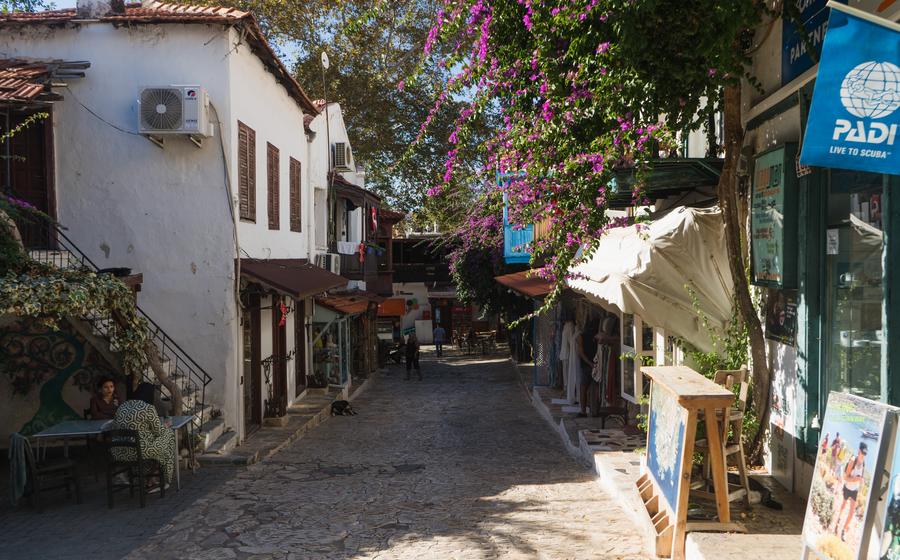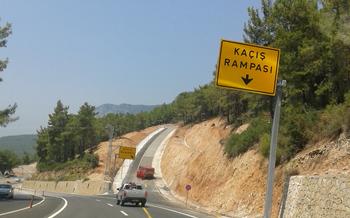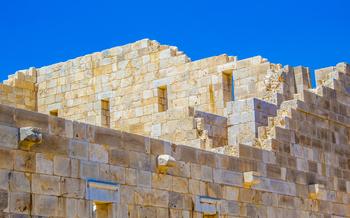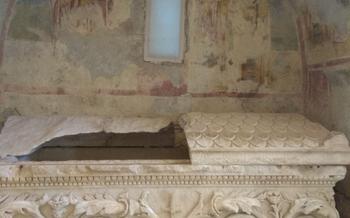
Patara Amphitheatre
- Historical Significance
- Architectural Marvel
- Natural Beauty
- Excavations and Discoveries
- Gladiatorial Contests
- Theatrical Performances
- Acoustics and Design
- Restoration and Conservation
- Local Legends and Myths
- Visitor Facilities and Amenities
- Best Time to Visit
- Getting There
- Nearby Attractions
- Accommodation and Dining
- Insider Tip: Unveiling the Secret Chamber
Historical Significance
Journey back in time and explore the ancient city of Patara, a place steeped in rich history and significance. As you wander through the ruins, you'll uncover the legacy of the Lycian League, a powerful confederation of cities that played a crucial role in the region's politics and culture. Patara served as the league's capital, hosting assemblies and shaping the destiny of Lycia.
The city's strategic location on the Mediterranean coast attracted the attention of various empires, each leaving its mark on Patara. The Romans, with their unrivaled engineering prowess, constructed the impressive amphitheatre and other architectural marvels. Later, the Byzantines ruled Patara, adding their own unique touches to the city's tapestry.
However, as time passed, Patara's fortunes waned. The rise of new trade routes and the gradual decline of the Roman Empire led to the city's eventual abandonment. Today, the ruins of Patara stand as a testament to its glorious past, waiting to be explored and understood.
Architectural Marvel
Behold the architectural marvel of the Patara Amphitheatre, a testament to the ingenuity and artistry of ancient civilizations. Step into this well-preserved relic and be transported back in time as you explore its grand seating tiers, stage area, and intricate decorative elements. Marvel at the remarkable acoustics that allowed performers to captivate audiences from every corner of the amphitheatre. Imagine the roar of the crowd as gladiators battled for glory or the laughter and applause that echoed through the air during theatrical performances. Each stone, each arch, and each carving tells a story, inviting you to unravel the secrets of this architectural wonder.
Natural Beauty
Immerse yourself in the captivating natural surroundings that embrace the Patara Amphitheatre. Discover the pristine beach with its golden sands that glisten under the Mediterranean sun, inviting you to bask in its warmth and take a refreshing dip in the crystal-clear waters. Explore the lush green valleys and rolling hills that encircle the amphitheatre, providing a picturesque backdrop for your exploration. Stand in awe of the panoramic vistas that stretch before you, encompassing the azure waters of the Mediterranean Sea and the majestic Taurus Mountains that stand as silent witnesses to the passage of time. Let the beauty of nature transport you to a realm of tranquility and wonder as you marvel at the harmonious coexistence of history and the environment at the Patara Amphitheatre.
Excavations and Discoveries
The ancient city of Patara has been the subject of extensive archaeological excavations, revealing a wealth of fascinating artifacts and insights into its rich history. Unearthed treasures include sculptures, pottery, and inscriptions that provide glimpses into the daily lives, customs, and beliefs of Patara's inhabitants. The Patara Museum, located near the amphitheatre, houses a collection of these artifacts, offering visitors an opportunity to delve deeper into the city's past. Through ongoing excavations and research, archaeologists continue to uncover new discoveries, shedding light on Patara's significance as a major cultural and commercial center in ancient Lycia.
Gladiatorial Contests
Prepare to be transported back to the thrilling and brutal world of ancient gladiatorial contests as you explore the Patara Amphitheatre. Imagine the roar of the crowd as fierce gladiators, armed with swords, shields, and tridents, battled for glory and survival in this very arena. Learn about the different types of gladiators, from the heavily armored legionaries to the agile retiarii with their nets and tridents. Discover the rigorous training and techniques these gladiators employed to become masters of combat. Explore the ethical debates surrounding these spectacles and the eventual decline of gladiatorial contests as public opinion turned against the brutality and bloodshed.
Theatrical Performances
The Patara Amphitheatre was not only a venue for gladiatorial contests but also a vibrant center for theatrical performances. Imagine the excitement and anticipation as audiences gathered for these events, eager to witness the latest plays, comedies, and musical spectacles. The amphitheatre's stage hosted a diverse range of productions, from tragedies that explored the human condition to lighthearted comedies that provided comic relief.
Ancient Greek and Roman playwrights, such as Sophocles, Euripides, and Plautus, were among the most celebrated authors whose works graced the Patara stage. Their plays addressed universal themes of love, loss, betrayal, and redemption, captivating audiences with their intricate plots and memorable characters.
Theatrical performances in Patara were not merely entertainment but also played a significant role in cultural and intellectual life. They provided a platform for social commentary, explored moral dilemmas, and celebrated the achievements and values of the community. The amphitheatre served as a gathering place where people from all walks of life came together to share in the collective experience of live theatre.
Acoustics and Design
The Patara Amphitheatre is renowned for its exceptional acoustics, a testament to the architectural brilliance of the ancient Greeks and Romans. The amphitheatre's design ensures that sound carries clearly and evenly throughout the seating tiers, enhancing the audience's experience. The curved shape of the seating rows and the strategic placement of niches and arches create a natural reverberation that amplifies and focuses the sound. This remarkable acoustic design allowed performers to project their voices without the need for amplification, ensuring that every member of the audience could hear and appreciate the performances. Exploring the acoustics of the Patara Amphitheatre offers a glimpse into the sophisticated architectural techniques employed by ancient civilizations to create immersive and engaging theatrical experiences.
Restoration and Conservation
The Patara Amphitheatre has undergone extensive restoration and conservation efforts to preserve its ancient splendor. Archaeologists and experts have meticulously worked to protect and restore the structure, using traditional techniques and materials that respect the integrity of the original design. The restoration process involved careful cleaning, stabilization, and repair of the seating tiers, stage area, and architectural elements. The aim is to maintain the authenticity of the amphitheatre while ensuring its stability and longevity. By safeguarding this cultural treasure, future generations can continue to appreciate and learn from this remarkable monument.
Local Legends and Myths
Patara is steeped in captivating local legends and myths that intertwine with the history of the amphitheatre. One enchanting tale tells of a beautiful maiden named Patara, who was beloved by the sea god, Poseidon. In his pursuit of her, Poseidon transformed himself into a dolphin and carried her away to his underwater kingdom. The amphitheatre is said to be the place where Patara's grieving parents watched as their daughter disappeared beneath the waves.
Another legend speaks of a fierce battle that took place in the amphitheatre between the gods Apollo and Dionysus. Apollo, the god of music and prophecy, was victorious, and in celebration, he established the Patara Oracle, which became renowned throughout the ancient world for its accurate predictions.
These legends and myths add a layer of enchantment to the Patara Amphitheatre, inviting visitors to explore the realm of ancient storytelling and mythology. As you wander through the ruins, let your imagination soar and connect with the rich cultural heritage that permeates this awe-inspiring site.
Visitor Facilities and Amenities
The Patara Amphitheatre offers a range of visitor facilities and amenities to enhance the experience of exploring this ancient wonder. Informative signage and exhibits provide detailed information about the history, architecture, and significance of the amphitheater. Guided tours, led by knowledgeable experts, offer visitors a deeper insight into the past, shedding light on the gladiatorial contests, theatrical performances, and cultural traditions that took place within these walls. Educational programs and workshops are also available for those seeking a more immersive and interactive learning experience. To ensure accessibility, the amphitheatre has been equipped with ramps and designated areas for visitors with disabilities. Additionally, there are restrooms, a small cafe, and a souvenir shop on-site for the convenience of visitors.
Best Time to Visit
Timing is crucial when planning a visit to the Patara Amphitheatre to ensure an optimal experience. The ideal period falls between April and June and September and October, characterized by pleasant weather and fewer crowds. During these shoulder months, the temperatures are moderate, ranging from the mid-60s to the low 80s Fahrenheit, making it comfortable for outdoor exploration. The summer months (July and August), while offering longer daylight hours, can be scorching, with temperatures often exceeding 90 degrees Fahrenheit. While this period attracts the most tourists, the intense heat may detract from the overall experience.
The winter months (November to March) bring cooler temperatures, occasional rain, and fewer visitors. While this period offers a more tranquil ambiance, some facilities and services may be limited, and the weather may not be conducive to outdoor activities.
Special events and festivals, such as the Patara Festival held annually in July, offer unique opportunities to immerse oneself in the region's culture and history. However, these events coincide with peak tourist season and may result in larger crowds and higher prices.
Ultimately, the best time to visit the Patara Amphitheatre depends on personal preferences, budget, and tolerance for heat and crowds. Consider these factors when planning your trip to make the most of your visit.
Getting There
Reaching the Patara Amphitheatre is a breeze, with multiple transportation options available to suit every traveler's needs. The closest airport is Dalaman Airport, approximately 100 kilometers away. From the airport, you can take a direct bus or arrange a transfer to Patara, which takes about two hours. Alternatively, you can rent a car at the airport and enjoy the scenic drive along the Turquoise Coast, immersing yourself in the stunning natural beauty of the region. If you prefer traveling by bus, there are regular services from major cities like Antalya and Fethiye to Patara. Once in Patara, you can easily reach the amphitheatre on foot or by taking a short taxi ride, allowing you to seamlessly integrate this ancient wonder into your exploration of the area.
Nearby Attractions
Beyond the captivating allure of the Patara Amphitheatre, the surrounding region offers a treasure trove of additional attractions that beckon curious travelers. Embark on a journey to Xanthos, a UNESCO World Heritage Site that unveils the grandeur of ancient Lycia, with its imposing acropolis, intricate rock-cut tombs, and a fascinating museum. Immerse yourself in the breathtaking beauty of Butterfly Valley, a sanctuary for a kaleidoscope of butterflies, where nature's artistry paints a vibrant canvas against the backdrop of secluded beaches and towering cliffs. Discover the enigmatic geological wonders of the Patara region, where caves adorned with stalactites and stalagmites whisper secrets of a forgotten past. From hidden coves to panoramic viewpoints, each nearby attraction promises a unique and unforgettable experience, inviting you to delve deeper into the rich tapestry of Turkey's natural and cultural heritage.
Accommodation and Dining
When planning your trip to Patara, you'll find a range of accommodation options to suit different budgets and preferences. From charming guesthouses and cozy bed and breakfasts to modern hotels with stunning sea views, there's something for every traveler.
For a truly authentic experience, consider staying in a traditional Turkish guesthouse. These small, family-run establishments offer a warm and welcoming atmosphere, along with the chance to sample delicious home-cooked Turkish cuisine. Many guesthouses are located within walking distance of the amphitheatre, making it easy to explore the ancient ruins and soak up the local culture.
If you prefer the comforts of a modern hotel, Patara offers several options with stunning views of the Mediterranean Sea and the surrounding mountains. These hotels often feature amenities such as swimming pools, spas, and rooftop terraces, where you can relax and unwind after a day of exploring.
When it comes to dining, Patara offers a delightful array of culinary experiences. From traditional Turkish restaurants serving mouthwatering kebabs and mezes to seafood restaurants specializing in fresh catches from the Mediterranean Sea, there's something to satisfy every palate. Be sure to try local specialties such as "Patara böreği," a crispy pastry filled with cheese and herbs, and "Patara salatası," a refreshing salad made with tomatoes, cucumbers, onions, and parsley.
Whether you choose to stay in a traditional guesthouse or a modern hotel, and dine in a local restaurant or enjoy a meal at your hotel, Patara offers a range of accommodation and dining options to complement your visit to the ancient amphitheatre.
Insider Tip: Unveiling the Secret Chamber
As you explore the Patara Amphitheatre, keep an eye out for a hidden chamber concealed beneath the stage area. This secret chamber was once used by gladiators and performers to prepare for their grand entrances. Imagine the anticipation and excitement as they waited their turn to step into the spotlight. Today, visitors can access this chamber through a discreet entrance, offering a unique glimpse into the behind-the-scenes world of ancient entertainment. Experience the thrill of walking in the footsteps of gladiators and actors as you discover this hidden gem of the Patara Amphitheatre.









